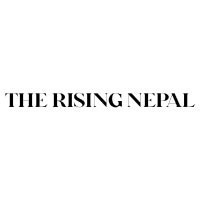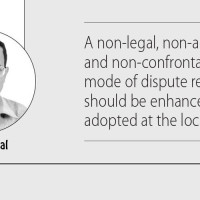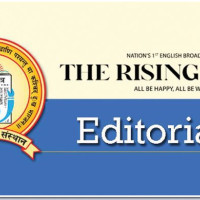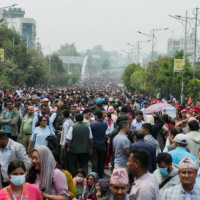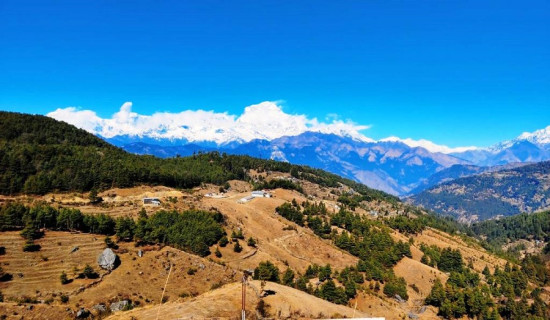- Thursday, 17 April 2025
Nepal In Midst Of Shifting Geopolitics
The world is at a turning point characterised by “perilous contradictions.” The world afflicted by the COVID-19 pandemic bears the brunt of long-term invisible human and economic effects and accelerating geopolitical tensions, conflicts, war, insurgencies and terrorism. President Donald Trump’s policy preferences are seen to contradict every aspect of the post-World War II order based on the pillars of democracy and economic liberalism.
Bipolarity ended with the end of the Cold War in 1990 and the subsequent dissolution of the Soviet Union in 1991. The unipolar world began with the unquestioned supremacy of the United States. Then came the 9/11 terrorist attacks on the USA, which forced it to launch the Global War on Terror (GWOT) in self-defense. The 2008-9 financial crisis, the emergence of a new economic club G20, and the rise of Xi Jinping as China’s president transformed the global geostrategic patterns and constellations. The post-1945 US-led liberal international order is under increasing contestation as the United States is withdrawing from world bodies and not standing and defending it.
Disruptions
Supply chains are disrupted. Transnationalism is on the rise. President Trump’s remarks on annexing Canada as the 51st state, taking over Greenland for economic security, controlling the Panama Canal, and turning the war-torn Gaza Strip into a “Riviera” are seen as provocative and a breach of the UN Charter. This indicates the return of age of the survival of the fittest maintaining “spheres of influence.”
Russia’s invasion of Ukraine in 2022 violated the purposes and principles of the United Nations Charter. The votes on the UN in the immediate aftermath of Russia’s invasion of Ukraine in 2022 and on its third anniversary in 2025 present a stark contrast, with the USA voting with Russia against the resolution supporting “the sovereignty, independence, unity and territorial integrity of Ukraine within its internationally recognised borders.” The war created a kind of crisis not seen after 1945. President Trump is trying to stop the war and is persuading two warring countries to cease fire.
Given the complex set of factors at play, working out a ceasefire without the inclusion of Ukraine’s representatives does not look that simple. The exclusion of Europe from the ceasefire dialogue is raising questions on the long-standing Trans-Atlantic Partnership. Eurasia has long been a focal point of geopolitical power. Its western part -Europe- and eastern region- Asia- occupy prominent positions in global politics and economics. Asia has been witnessing a remarkable surge in political and economic influence in recent years. This has made Eurasia “a chessboard witnessing the struggle for global primacy.”
With a large number of countries emerging as global players to developing and least developed and landlocked nations, Eurasia represents one of the most significant geopolitical challenges of the 21st century. The unfolding geopolitical landscape brings several messages for weak and vulnerable states like Nepal, located between India and China in South Asia, which is home to one fifth of the world’s humanity, and presenting a more complex and polarised environment. The region is centered on India, the world’s largest democracy and largest country in the region, the world’s most populated with fifth military standing, and one of the fastest growing economies.
South Asia is seen as the most ‘militarised, least gender sensitive, most deprived region and epicenter of global terrorism ’. Nepal, Bangladesh, Bhutan, India, the Maldives, Pakistan and Sri Lanka came together in 1985 to form the South Asian Association for Regional Cooperation (SAARC). Afghanistan joined later. The two largest members of the SAARC, India and Pakistan, carry congenital conflicts. The Cold War between them seems to have never ended. This has made South Asia a fissiparous region holding back huge potentials.
Nepal’s immediate and colossal neighbors – India and China - are seen in two opposite poles, divided on contemporary issues. The only super power, the United States, considers Nepal as its “neighbour on the other side of the globe.” Nepal’s location carries considerable strategic significance for its immediate neighbours, India and China, as well as for the United States. Other great powers also show close interests in Nepal. It is no secret that great power rivalry has arrived at Nepal’s doorsteps, involving not only its neighbours but also the United States and China. All these powers have competing and conflicting interests in Nepal.
As India and Western powers seek to increase their involvement in Nepal, China responds by strengthening its influence to win Nepali hearts and minds. At a time when Nepal needs a solid domestic foundation, “there is a preponderance of self-seeking behaviour, communalism, individualistic mentality and a tendency to look to foreign hands,” making “nationalism a first casualty,” as BP Koirala warned in 1976. This tendency has flourished over the years and exposed the country to geopolitical maneuverings and counter-maneuverings by external powers.
Nepal must allow state institutions to function effectively. However, these institutions are packed with party loyalists. The culture of “state capture” has politicised them, shattered their integrity and demoralised state officials. Corruption has deeply penetrated state institutions, including the highest levels of political leadership. Nepal must reverse much of the damage done over these years to remove itself from the grey list that was imposed on it due to “corruption, mishandling of funds by the government, questionable governance and inadequate leadership.” This trend has severely undermined the principle of separation of powers and created several fault lines at all levels.
Non-aligned foreign policy
Nepal has a long and rich tradition of non-aligned foreign policy and balanced diplomacy, rooted in its identity as a sovereign and independent nation. Nepal refuses to take sides of any neighbours and major powers and has demonstrated its skill of balancing “its diplomatic posture,” maintaining constructive, transparent, and mutually beneficial engagements with India, China, the United States, and other powers. Nepal’s non-aligned legacy demands a focus on issue and interest-based engagements, fully aligning such engagements with the nation’s interests and priorities. The pursuit of non-alignment also ensures that no single power has a domineering position.
Nepal remains committed to democratic pluralism at home and multipolarity in international relations. All eyes are on Asia, which is emerging as the brightest spot. Given Nepal’s geostrategic location, maintaining a friendly, balanced and cooperative relationship based on mutual trust and respect with its neighbours- India and China, the United States and other great powers would help secure national space and safeguard national dignity while contributing to global peace, stability and prosperity.
(The author is a former Ambassador.)


